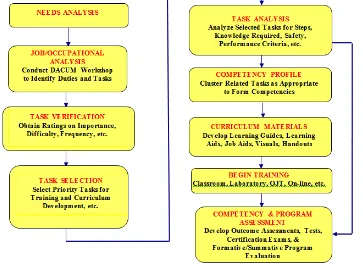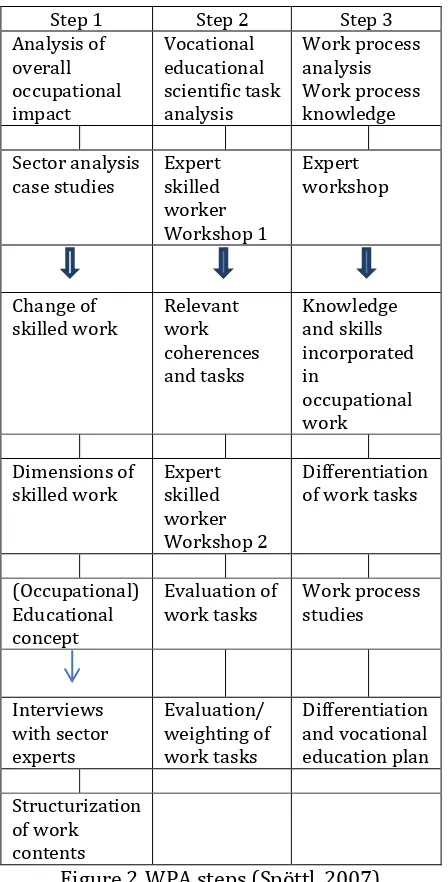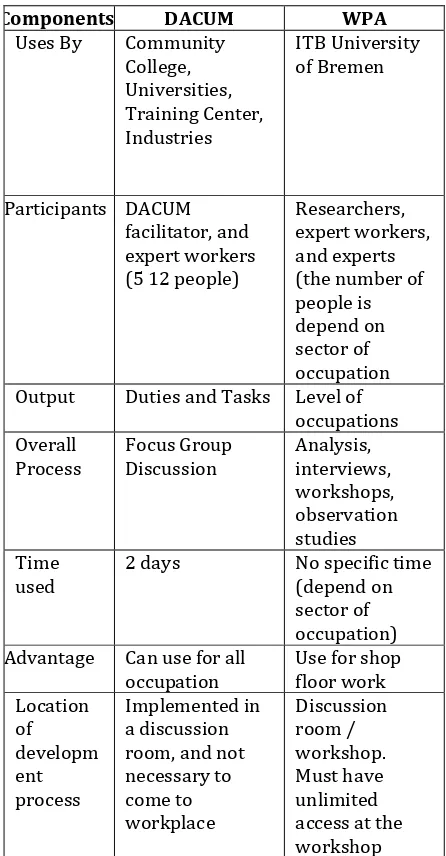53
COMPARISON BETWEEN THE DACUM AND WORK PROCESS ANALYSIS FOR VOCATIONAL SCHOOL CURRICULUM DEVELOPMENT TO MEET WORKPLACE NEED
BernardusSentotWijanarka
Department of Mechanical Engineering Education, Faculty of Engineering, Yogyakarta State University
Abstract
Curriculum development to meet workplace need of vocational education can be reached through a number of procedures. A procedure for the development of the curriculum used by vocational education experts from ITB Germany is work process analysis (WPA). The result of WPA is the steps of the task. The education experts in the United States and Canada use DACUM (Development a Curriculum). The result of DACUM is: duties and tasks of an occupation. This paper will compare the two curriculum development procedures. The aspects to be compared are: the steps, the results obtained, the time required, the number of personnel involved, advantages, and disadvantages.
Keywords: work process analysis, DACUM, vocational
1. Introduction
According to Law no. 20 of 2003 on National Education System in Indonesia, the curriculum is a set of plans and arrangements regarding the purpose, content, and learning materials and methods used as a guide implementation of learning activities to achieve specific educational goals. The purpose of education is mainly determined by the type of education, namely: general education, vocational education, academic, professional, vocational higher education, religious, and special. Content and teaching materials developed in accordance with the level of education, while learning how to implement activities include teaching methods and evaluation of learning. Therefore, it can be said the quality of education at all levels and types depend on the implemented curriculum.
Development of curriculum content can be implemented in several ways, namely: philosophical approach, introspective, DACUM, functional, and analysis tasks (Soekamto: 90, 1988).Each expansion of the curriculum content has advantages and disadvantages. Advantages and disadvantages are closely related to the purpose of learning that is tailored to the type of education. The expansion of the public school curriculum and vocational education is different. Due to the different
nature especially for educational purposes, it must be adapted to the needs of graduate competencies.
Philosophical, introspective, and functional approach normally appropriate to develop academic education curriculum content. While the DACUM approach and analysis tasks appropriate for developing curriculum in vocational education. DACUM useexpert workers as participants who can be invited to discuss and develop some duties and tasks of a particular occupation. Approach to curriculum development is especially developed by the American and Canadian education.
Faculty members of vocational of technical education ITB University of Bremen produced a Work Process Analysis (WPA) to develop vocational education curriculum. WPA emphasizes the development process of a major expansion of work into the content of the curriculum through the process of observation in the workplace. WPA is the result of the measures implemented in the form of a specific job in the workshop.
54
of this study are expected to contribute tocurriculum development in vocational education in Indonesia.
2. DACUM
The first references to DACUM were in 1966 where it began in its very early stages as a new approach to curriculum development with Iowa Job Corps at Clinton, Iowa. Following used by Nova Scotia NewStart, Inc, in 1968.DACUM was adopted by Holland College in Charlottetown P.E.I Canada, in 1969 through the efforts of then-president Donald Glendenning and program specialist Larry Coffin (Norton and Moser, 2008).
DACUM is an acronym for developing a curriculum. It is a one or two day storyboarding process that provides a picture of what the worker does in terms of duties, tasks, knowledge, skills, traits and in some cases the tools the worker uses. The information is presented in graphic chart form and can include information on critical and frequently performed tasks and the training needs of workers (http://www.dacum.org/). Other expert state that DACUM (Developing a Curriculum) is a job-oriented task analysis process which seeks to answer what skills and knowledge are required to perform a particular job at a certain proficiency level.
The DACUM process provides information about theoretical knowledge, practical skills, and personal attitudes or dispositions needed to equip a person to perform at a particular level (Dixon and Stricklin, 2014).
DACUM is based on three logical premises (Norton and Moser, 2008:1): (1) expert worker can describe and define their job/occupation more accurately than anyone else, (2) an affective way to define job/occupation is to precisely describe the tasks that expert workers perform, (3) all tasks, in order to be performed correctly, demand the use of certain knowledge/skills, tools, and positive worker behaviors. Based on these three premises, the DACUM process is very effective for analyzing work in: professional, managerial, supervisor, technical, and skilled and semi-skilled levels. In other hand DACUM can use for conceptualize future jobs, and to analyze portions (selected duties of one’s occupation. At this time of the adoption of TQM, ISO 9000, the quality of the other's management system, DACUM is also often used to analyze several systems and processes in the industry. DACUM is used to find the duties and tasks for a job. The process of curriculum development using the DACUM follows the steps below Figure 1 (Norton, 2008: A-15).
55
The results of research conducted bythe manager of vocational education show results the use of DACUM for curriculum development. Dixon and Stricklin (2014) conducted a job analysis to identify the competency profile of an entry level CADD technician in North central Idaho. A total of seven expert workers from six companies participated. The results of the reach were: The DACUM research chart created consisted of 8 duty statements and 54 task statements. Conclusions of the studied: Effective facilitation helps to reduce self-serving biases. The panel of experts believed the modified DACUM expedited the development of a new DACUM Research Chart that is reflective of what is done in the region.
Another study conducted by Hyun-Sook,at all (2012), study was done to analyze the job of clinical research coordinators (CRCs). In this study, the roles of CRCs were defined using the DCUM job difficult and frequent duties were participant management and research review/supervision organization administrative work, and the least important, difficult and frequent one was the management of research facilities and materials.
Johnsons (2010)developed job analysis for technicians in Geospatial in United States. This study was undertaken by the National Geospatial Technology (GeoTech) Center to assist in this effort to validate the DOLETA’s occupation-specific workforce requirements. Validation is performed using the DACUM (Developing aCurriculum) job-analysis technique, which relies on workers themselves to describe and define their jobs. Building on the strength of this approach, the GeoTech Center developed and applied a meta-analytic technique for consolidating multiple DACUM job analyses into a single national assessment. Using eight GIS technician job analyses from across the country, this assessment identifies 55 common task categories, 35 knowledge and
skill categories, and 27 behavior categories that are ranked and documented. This helps to clarify the job responsibilities of GIS technicians and complements the DOLETA’s workforce information.
56
3. Work Process Analysis (WPA)Technological advances are happening very quickly now. The speed of technological progress can not be followed by the school world, so that what is taught in vocational schools is different to that of the world of work / industrial world. The gap will continue to happen when the content of curriculum development based on the concept that only happened in the past, but graduates will work in the future (3 or 4 years). WPA will solve the problem because the content of the curriculum based on the result of work in the industry,
Figure 2.WPA steps (Spöttl, 2007)
A work process is a complete flow of work aiming to complete an operational task and always has an output. Learning in vocational schools in Germany has changed from teaching and learning to focus on workplace (Schulte and Spöttl, 2012). WPA consists of three steps: (1) analyzing of overall occupational impact, (2) vocational educational scientific task analysis, and (3) work process analysis – work process knowledge. Third step is basically consisted of a case study and interviews, workshops twice with experts skilled worker, and a one-time workshop with experts. WPA step such as the Figure 2 (Spöttl, 2007).
The results of Spöttl (2007) studied on car maintenance workshop raised four levels of work, namely: (1) Level 1: the car is entity: the basic service; (2) Level 2: the car and its architecture: service and wear repair; (3) Level 3: the car and its aggregates: trouble shooting and repair; and (4) Level 4: the car and its construction: experts diagnosis and repair. Research result in recycling sector found four levels, namely: (1) level 1: recycling and the principle of the material flows; (2) level 2: material closed loops; (3) level 3: used material and their utilization; and (4) level 4: used material in recycling plants.
Based on the description above, it can be said that the WPA produce the level of work in a particular sector. Level depicts the development of a skill level from novice to expert. Each level contains learning opportunities which are determined by the corporate work tasks as a crystallization point of organizational forms of corporate processes and the business. Therefore, it can be argued that work-based learning process is needed in the vocational school. Skills and knowledge taught in a particular sector should be analyzed carefully in order to appropriate the necessary competencies among graduates of vocational schools and the world of work can be improved.
57
4. Comparison between DACUM andWPA
Based on the description of the two processes of curriculum development above, it can be compared to the components (Table 1). The following will be compared regarding: the user, of participants, output, process, time used, and advantages.
Based on Table 1 it can be concluded that both the curriculum development process differs in: process, time, and the results obtained. About which one is better, can not be decided in this paper due to the use of a process is highly dependent on the objectives to be achieved.
5. Conclusions
From the description and comparison of the above, it can be concluded:
1) DACUM is appropriate to develop duties and tasks to the needs of the task analysis and curriculum development of vocational education
2) Work process analysis is appropriate to develop the level of occupation, especially in workshops level
3) DACUM and WPA have their own advantages and can be used both for the development of vocational education curriculum.
Recommendation
Development of vocational education curriculum, especially in Indonesia, should not only use the philosophy and introspection approach. DACUM and WPA should be used to develop vocational education curriculum in order to increase the relevance of what is taught in schools and the needs of the workforce.
Table 1. Comparison between DACUM and WPA
Components DACUM WPA
Uses By Community College, Output Duties and Tasks Level of
occupations Advantage Can use for all
occupation Do: A Synthesis of DACUM Job Analyses, URISA Journal, Vol. 22, No. 2, 2010, pp.31-40.
58
[5] R. A. Dixon, and L.S. Stricklin, LessonsLearned Using The Modified DACUM Approach to Identify Duties and Tasks for CADD Technicians in North Central Idaho , Online Journal for Workforce Education and Development, Vol. VII, Issue 1 – Spring ,2014.
[6] R.E. Norton, and J.R. Moser, DACUM Handbook, 3rd ed., CETE College of
Education and Human Ecology OSU: Ohio, 2008, pp.1-15
[7] R.H. Linton, at all, Use of a Stakeholder -Driven DACUM Process to Define Knowledge Areas for Food Protection and Defense, Journal of Homeland Security and Emergency Management.Vol. 8, Issue 2, 2011, Article 6.


